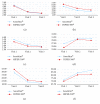Effects of a Newly Developed Therapeutic Deep Heating Device Using High Frequency in Patients with Shoulder Pain and Disability: A Pilot Study
- PMID: 31191789
- PMCID: PMC6525801
- DOI: 10.1155/2019/8215371
Effects of a Newly Developed Therapeutic Deep Heating Device Using High Frequency in Patients with Shoulder Pain and Disability: A Pilot Study
Abstract
Objectives: The newly developed therapeutic deep heating device can generate deep heat in focal tissue using high-frequency wave stimulation. The objective of this study was to evaluate and compare the effectiveness of this deep heating device (HIPER-500®) with ultrasound in alleviating pain and improving function in patients with shoulder disability.
Methods: This noninferiority trial was designed to compare the treatment effect of HIPER-500® to that of SonoStim® (ultrasound) on shoulder pain and disability. Thirty-eight patients with shoulder problems were assigned to either the HIPER-500® or SonoStim® group, and each participated in 10 min therapy sessions, five days a week for two weeks (for a total of ten sessions). Shoulder pain and disability were evaluated using the Visual Analogue Scale (VAS), the University of California at Los Angeles score (UCLA score), the Shoulder Pain and Disability Index (SPADI), and the Constant score in both groups before, immediately after, and four weeks after treatment. Statistical analysis was performed to compare the effects of treatment within and between the groups.
Results: A total of 34 patients completed the study. The 18 patients in the HIPER-500® group and 16 patients in the SonoStim® group all showed significant improvements in shoulder pain and function when comparing pretreatment values with the results immediately after treatment and four weeks later. The results before and after treatment did not show a statistically significant difference between the two groups.
Conclusions: The newly developed HIPER-500® for high-frequency deep heat therapy showed similar effects to those of SonoStim® for relieving pain and improving physical performance in the patients of this study. HIPER-500® may be a useful modality for treating shoulder pain and improving physical activity in patients with shoulder disease.
Figures





Similar articles
-
Interferential laser therapy in the treatment of shoulder pain and disability from musculoskeletal pathologies: a randomised comparative study.Physiotherapy. 2012 Jun;98(2):143-50. doi: 10.1016/j.physio.2011.02.007. Epub 2011 May 28. Physiotherapy. 2012. PMID: 22507365 Clinical Trial.
-
Comparing complementary alternative treatment for chronic shoulder pain of myofascial origin: Collateral meridian therapy versus local tender area-related meridians therapy.Medicine (Baltimore). 2016 Aug;95(35):e4634. doi: 10.1097/MD.0000000000004634. Medicine (Baltimore). 2016. PMID: 27583882 Free PMC article. Clinical Trial.
-
The effects of Clinical Pilates exercises on patients with shoulder pain: A randomised clinical trial.J Bodyw Mov Ther. 2017 Oct;21(4):847-851. doi: 10.1016/j.jbmt.2017.02.003. Epub 2017 Mar 4. J Bodyw Mov Ther. 2017. PMID: 29037638 Clinical Trial.
-
The Responsiveness and Interpretability of the Shoulder Pain and Disability Index.J Orthop Sports Phys Ther. 2017 Apr;47(4):278-286. doi: 10.2519/jospt.2017.7079. Epub 2017 Feb 3. J Orthop Sports Phys Ther. 2017. PMID: 28158958
-
Radiofrequency Ablation for Management of Shoulder Pain.Curr Pain Headache Rep. 2019 Jul 10;23(8):56. doi: 10.1007/s11916-019-0791-z. Curr Pain Headache Rep. 2019. PMID: 31292738
Cited by
-
A Comparison of the Effect of a 4.4-MHz Radiofrequency Deep Heating Therapy and Ultrasound on Low Back Pain: A Randomized, Double-Blind, Multicenter Trial.J Clin Med. 2022 Aug 26;11(17):5011. doi: 10.3390/jcm11175011. J Clin Med. 2022. PMID: 36078940 Free PMC article.
-
Electromagnetic Field Therapy: A Rehabilitative Perspective in the Management of Musculoskeletal Pain - A Systematic Review.J Pain Res. 2020 Jun 12;13:1385-1400. doi: 10.2147/JPR.S231778. eCollection 2020. J Pain Res. 2020. PMID: 32606905 Free PMC article. Review.
-
Effects of Transfer Energy Capacitive and Resistive On Musculoskeletal Pain: A Systematic Review and Meta-Analysis:Galen Med J. 2022 Nov 17;11:e2407. doi: 10.31661/gmj.v11i.2407. eCollection 2022. Galen Med J. 2022. PMID: 36698689 Free PMC article.
-
Efficacy of Transcutaneous 4.4 MHz Radiofrequency Diathermy versus Therapeutic Ultrasound for Pain Relief and Functional Recovery in Patients with Knee Osteoarthritis: A Randomized Controlled Study.J Clin Med. 2023 Sep 18;12(18):6040. doi: 10.3390/jcm12186040. J Clin Med. 2023. PMID: 37762980 Free PMC article.
-
Effectiveness of Gyejibongnyeong-Hwan for shoulder pain: study protocol for a randomised, wait-list controlled pilot trial.Trials. 2020 Feb 17;21(1):193. doi: 10.1186/s13063-020-4092-y. Trials. 2020. PMID: 32066487 Free PMC article.
References
-
- Urwin M., Symmons D., Allison T., et al. Estimating the burden of musculoskeletal disorders in the community: the comparative prevalence of symptoms at different anatomical sites, and the relation to social deprivation. Annals of the Rheumatic Diseases. 1998;57(11):649–655. doi: 10.1136/ard.57.11.649. - DOI - PMC - PubMed
-
- Basford J. R., Baxter G. D. DeLisa’s Physical Medicine and Rehabilitation: Principles and Practice. 5th. Alphen aan den Rijn, Netherlands: Wolters Kluwer Health Adis (ESP); 2012. Therapeutic physical agents.
Publication types
MeSH terms
LinkOut - more resources
Full Text Sources
Medical

